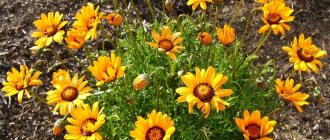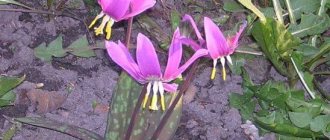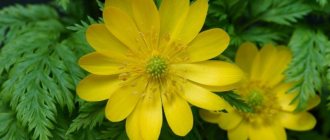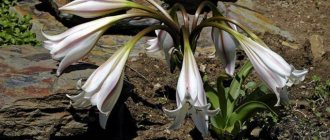Features of the Marine variety
"Marin" is a tree-like heliotrope that grows up to half a meter in height. Its origin is Ecuadorian and Peruvian.
In its homeland it is a perennial plant; its height can be about 2 meters. In our conditions, heliotrope cannot overwinter outside.
The inflorescences are a rich blue-violet color, 15 centimeters in diameter. Grows and develops quickly.
The first flowering occurs in the same year as sowing. Blooms from June until the onset of frost. Hybrids "Marina" - "Mini Marin", "Dwarf Marin" and "Marin Blue".
Signs of the heliotrope genus:
- leaves with short stalks;
- the arrangement of leaves is alternate;
- small flowers collected in inflorescences in the form of corymbs;
- coenobium - a fruit consisting of 4 nut parts - contains very small seeds (1.5 thousand seeds weigh only 1 gram);
- fragrant due to the content of essential oil in the inflorescences (the smell of vanilla).
Planting and caring for heliotrope
- Planting: sowing seeds for seedlings - at the end of February or early March, planting seedlings in the ground - at the beginning of June.
- Flowering: from June to frost.
- Lighting: bright sunlight.
- Soil: fertile, loose, well-drained and rich in humus.
- Watering: as needed: young plants - often, adults - after the top layer of soil has dried.
- Feeding: from the seedling period to the peak of flowering once every 2 weeks with complete mineral fertilizer.
- Reproduction: seeds and cuttings.
- Pests: aphids, whiteflies, spider mites.
- Diseases: gray rot, rust.
Read more about growing heliotrope below.
Selecting a location
The location for the Marine variety should be sunny. He prefers loose soil, with good water permeability and an abundance of organic matter. It is great if the plant is protected from rain and wind.
In addition to gardens , the flower is grown in rooms, on balconies, on terraces, and in flower beds. Heliotropes are used to form borders.
Read with us about the propagation of syngonium.
Caring for schefflera flowers requires skill. More about this.
Common types and varieties
Heliotrope has long been loved by people. It has a sweet aroma and attractive appearance. And you don’t see him very often. Many people consider heliotrope to be a capricious plant. And because of this, they refuse to grow.
Tree-like heliotrope is popular among domestic gardeners. Its aroma is bright, the flower is rich. In most cases they are white, but some varieties have colored petals.
- Marin. This variety grows as a dense 50 cm bush. The flower is bright purple, the diameter of the inflorescences reaches 15 centimeters. The smell is rich and very pleasant. If all agricultural practices are followed, Marin will bloom in the first year.
- Marine Blue. A medium-sized bush, the height of which does not exceed 40 centimeters. The flowers are purple, bright pink. The smell is somewhat reminiscent of fermented cherries, but it does not cause disgust.
- Sea breeze. Dwarf bush - its height does not exceed 30 centimeters. Blooms profusely, purple. The homeland of the variety is South America. The bush grows well both in open ground and as a potted crop.
- White Lady. Attractive bush with large inflorescences. When the buds have not yet bloomed, they are pink, but over time they become snow-white.
- Princess Marin. The height of the plant is no higher than 30 centimeters, it is closed towards the top. Produces bright purple buds that emit a pleasant aroma.
- Regal Dwarf. Suitable for growing in limited areas. Compact, fragrant, blooms brightly. Unpretentious, but requires regular mineral fertilizing.
- Fragrant Delight. A variety of heliotrope, including about 10 species. The colors are different - it can be either lavender or bright purple. Has a pronounced vanilla smell.
- Baby Blue. Designed for growing as a houseplant. It blooms brightly and abundantly, in lilac tones. The smell is not pronounced, has vanilla notes.
Planting in open ground
Seedlings are planted in open ground when frosts stop, before heliotrope begins to bloom.
To prepare the shoots for this procedure, they are first periodically taken outside and hardened off. Hardening begins at the end of April.
When planting, 20 to 30 centimeters are left between shoots, and humus (leaves or manure) is placed in the holes. In the first week after planting Marine in the ground, you need to provide shade and spray with water twice a day.
Heliotrope care
Rules of care
Growing a heliotrope flower requires, first of all, proper soil moisture. Watering heliotrope is carried out as needed; in dry summers it is necessary to water more often. After watering, it is necessary to carefully loosen the soil between the bushes and remove weeds. If you have mulched the soil on your site, then you will have to loosen and weed the weeds much less often. How, by the way, to water.
Feed heliotrope once every two weeks with a complete complex fertilizer until active flowering begins.
In the photo: Heliotrope inflorescence
Pests and diseases
Heliotrope is damaged by spider mites, aphids and whiteflies. To combat these pests, plants are treated with Actellik. If the problem cannot be eliminated immediately, treatment with Actellik should be repeated after a week.
Sometimes the plant gets sick with gray rot. This is a fungal disease, which can only be gotten rid of in the initial stages by treating with a fungicide.
Properties of heliotrope
In addition to its enchanting aroma, heliotrope has other wonderful properties: for example, it has long been used in folk medicine as an anthelmintic or a cure for kidney stones, as well as a means for removing warts and treating lichens. But due to the fact that heliotrope contains a dangerous alkaloid, the German federal health authorities, for example, even removed it from use.
- Planting flowers for seedlings in April
So be careful, and if you want to experience the healing effects of heliotrope preparations, consult your doctors first.
In the photo: Purple heliotrope
Reproduction
At first , heliotropes were propagated exclusively by cuttings. With the development of selection, varieties appeared whose propagation became possible not only by cuttings, but also by seeds. Among them is heliotrope “Marin”.
Cuttings . The mother plant is carefully dug out of the soil with a lump of earth, placed in a container and brought into a warm room to overwinter.
be watered as the soil dries out. In February (in the middle of the month) cuttings are made from it. Each shoot should have 3 or 4 internodes. There is no need to leave a lot of leaves on the shoot: this will weaken it.
Sand and humus are poured into the boxes Before planting the cuttings, they are kept in a special composition for root formation.
After planting in the substrate, the shoots are covered with film and wait for the roots to appear, watering the cuttings daily and ventilating them for half an hour, opening the film. Typically, it takes 3 weeks for roots to form. Then the cuttings are transplanted into soil that is more nutritious in composition: peat, turf and sand in a ratio of 4: 2: 1.
The soil is fertilized with a complex fertilizer containing minerals. For the first week, young plants should not be exposed to direct sunlight; they should be sprayed with water at a temperature slightly above room temperature 2 times a day.
To make future bushes compact, seedlings are repeatedly pinched as they grow. They are planted in open ground after the end of frost in the spring, leaving a distance of 20 centimeters between plants.
Seeds . Planting months: January, February, March. To grow seedlings, Russian seed producers recommend scattering heliotrope seeds over the surface of the ground, pressing them in, but not covering them with anything. European manufacturers recommend covering scattered seeds with a 3-mm layer of soil.
The germination period is up to 20 days. The boxes should be kept warm and illuminated, since light is necessary for seed germination. After 37 days, the sprouts are distributed into separate containers and the containers are placed in a cooler room with ventilation.
The plant will be bushy if you pinch out the shoots as they grow.
Growing heliotrope from seeds
How to sow seeds
For those who want to know how to grow heliotrope from seeds, it is important to remember that it is better to buy heliotrope seeds in specialized stores, and you need to take only seeds from well-established brands, for example, Prestige, Search, Johnsons or Unwins Seeds - these companies guarantee quality and high grade of seed material. If you buy good seeds, then from the moment of germination, heliotrope from seeds will bloom in 12-16 weeks.
How to grow lobelia - planting and care
Growing heliotrope from seeds collected by yourself can be a problem: they do not germinate well, and heliotropes grown from them bloom only towards the end of summer, and the bushes turn out to be different in height, and the inflorescences are too small.
In the photo: Heliotrope flowering
sow heliotrope seedlings in late February or early March. Mix four parts of peat with one part of sand, steam this mixture to avoid infection of the seeds with fungal diseases, fill the bowl with the soil mixture, compact the soil with a plank, scatter heliotrope seeds evenly over the surface and lightly sprinkle them on top with the same soil mixture - in a layer of no more than 1- 2 mm. Cover the bowl with glass to create a greenhouse effect and place in a warm place – 18-20 ºC.
As soon as the shoots appear, and this will happen on the fifth, or maybe on the twentieth day, remove the glass and place the bowl on the windowsill. The optimal temperature for this stage of seedling development is 20-22 ºС. Seedlings do not need bright light; they develop normally without it.
Seedling care
After the seedlings have two true leaves, they need to be picked into individual pots with a diameter of 9 cm in the same soil mixture; after picking, the seedlings are watered. Two weeks after picking, young heliotropes are fed with seedling fertilizer.
- Matricaria: growing in the garden, types and varieties
Diseases and pests
Whitefly. The plant needs to be treated with an insecticide 2 times (every week).
Spider mite. Cobwebs, pale spots on the underside of leaves. Because The tick is not an insect; fighting it with insecticides is ineffective.
Acaricides or insectoacaricides are needed For example, Apollo. The biological method of control is phytoseiulus mites, which eat other mites.
Aphid . Repeated treatment with insecticide.
Propagation by cuttings
The most convenient and fastest way to propagate heliotropes is by cuttings. Choose old large specimens without signs of damage. Young shoots with 2-3 buds are suitable for cuttings. Professional harvesters specifically preserve the old mother bush, from which young branches are separated. They take root better and faster and grow rapidly.
It is best to take cuttings in winter, when the temperature in greenhouses drops to 8-15 degrees. After this, the most attractive cuttings are selected and cut off. The cut is treated with a growth stimulator, after which the plant is placed in a substrate. To make it evaporate less moisture, large leaves are cut off and the top ones are shortened by half.
It is best to store cuttings under glass or film in a lighted place. They are watered a little every day. When you realize that the heliotrope has begun to grow, the film is removed. The bush is placed on the sunny side and watered every other day.
You can add mineral complex fertilizers to make development more intensive. By the time of planting, you will be able to get a branched bush.
Heliotrope in landscape design
In landscape design, semi-shrub varieties are the most popular. Airy lush inflorescences perfectly decorate lawns and gazebos. Low-growing varieties are used for planting next to borders or coniferous trees. Tall varieties are acquired as a background.
In pots and original flowerpots, heliotrope will decorate the terrace, balcony or entrance to the house.
The culture goes well with rose bushes, coleus, rudbeckias or begonias.
Petunias or Chernobrivtsa would be appropriate as the bottom row in a complex planting.
Among gardeners, the most favorite varieties are European, stem-bearing and Peruvian. They are popular due to their long flowering and resistance to cold.
Decorating stairs with heliotrope
Heliotrope cuttings
Tree heliotrope is a very demanding garden inhabitant. But still, thousands of gardeners propagate it using cuttings. March and April are a favorable period for this method. Cuttings are planted in peat soil fertilized with humus. The microclimate should be humid and the temperature should not be lower than 18 degrees. It is advisable to create a miniature greenhouse for it. A jar or film is most suitable, but do not forget about daily ventilation. When roots appear, the sprouts are transplanted into separate containers. When the roots take root, they are safely transferred to a permanent place.
Heliotrope hybrid
Hybrid heliotrope is characterized by an upright position, with the stems branching quite strongly to the sides. The leaves are dark green in color and have a long, elongated shape resembling an oval. The height of this plant variety sometimes reaches fifty centimeters. The inflorescences can have a white, purple or lilac tone, and the size reaches fifteen centimeters in diameter.
Heliotrope, which grows in a flowerpot, must be periodically taken out onto the balcony, otherwise it will begin to stretch.
This variety is most common for growing indoors.
Landing
The presentable appearance of the plant depends on the planting substrate, lighting, fertilizing and regular watering. The leaves wither and fade if the crop grows in the shade. Therefore, you should choose the southern or southwestern side of the site for it. At home, the plant needs high-quality and daily ventilation.
You should use soil without clay impurities. Preference should be given to loose and lighter substrates.
To plant a heliotrope flower, you should buy special soil for shrubs and then provide the seedling with proper care, as shown in the photo. You can create the substrate yourself. For this you need the following components:
- turf and deciduous land;
- coarse sand;
- high-quality manure humus;
- charcoal ground into ashes (1-2 handfuls);
- non-acidic peat;
- Expanded clay is used as drainage.
Peat and soil are the largest parts in the substrate, and all the rest should be taken an order of magnitude smaller. Then you should dig a large hole, lay drainage at its bottom, cover it with organic fertilizer, and then carefully lay the seedling. The roots need to be straightened, and then covered with prepared soil in small portions. At the end, you should press the soil near the root collar and water the bush generously.
Some sprouts can be pinched off to make the flowerpot more voluminous.
Main problems when growing
In order to prevent the main mistakes that novice gardeners make when growing, we recommend that you familiarize yourself with the list of the main problems that arise most often when growing this flower.
- Withering of buds. A similar problem most often occurs after rain, since drops fall inside the inflorescence and remain there for quite a long time. If you want to avoid such a development of events on your site, then take care in advance to protect your plants from rain, for example, build a canopy from film or polycarbonate.
- Excessive spreading of bushes. A fairly common occurrence in the flowerbeds of novice gardeners. To form the volume of the plant, it is necessary to regularly tie up young branches using slats and nylon thread. Also, do not be afraid to trim off an excess shoot if it does not fit into the decorative appearance of the bush.
- Dry tips of leaves. A clear indicator of a lack of moisture in the soil, which most often manifests itself in the summer. It is recommended not only to water the crop in a timely manner, but also to take care of a source of additional shading. For example, you can use garden netting.
As you can see, growing heliotrope at home is not difficult if you know the basic rules for caring for this flower. If you follow the recommendations given above, the plant will definitely delight you with its decorative appearance and enchanting aroma.
Propagation by seeds
The Marin heliotrope is recognized as the most optimal exhibit for the garden, because it produces lush colors and branches well. Experts recommend growing it exclusively from seedlings. Seeds may not produce the required shoots. Gardeners practice starting sowing after the last frost has passed - in March. As a result, the first sprouts can be seen in a month, and gorgeous flowering in four. To speed up the process of growing heliotrope from seeds (you can look at their photos), you should follow the following procedures:
- Cotton fabric is impregnated with a growth accelerator. The seeds are wrapped in it and left on a plastic tray. As the material dries, add a solution. The procedure is carried out within 2-3 days.
- Instead of regular soil, pressed peat tablets are used.
- Soak the seeds in the solution for 24 hours. Silver or zircon is used as a growth accelerator. Add 6 drops of the selected chemical element to a glass of warm liquid. Before sowing, the seeds need to be dried on a towel.
Such actions will protect the heliotrope plant from diseases and pests, and will also make it more resistant to temperature changes. At the same time, the gardener will see the first shoots after 10 days, not 30. When more than two leaves appear on the stems, and this will happen in one and a half or two months, the seedlings dive in 2 passes. First, they are transplanted in batches of 6-10 pieces. in one container. After they grow a little, they are transferred to pots: individually or in groups (the distance between them is 10-15 cm).
It is important to tie up flowering branches so that the flower bed looks solid. Otherwise, the heliotrope will “fall apart” on the site, turning into carpeting.
Sea breeze heliotrope flower
The height of this variety of heliotrope reaches a maximum of forty-five centimeters. The flowers grow up to twelve cm in diameter.
The bush begins to bloom from the beginning of June, and ends at the end of October, when the first frosts have already arrived. Experienced gardeners begin sowing sea breeze seeds in April, since after 60 days it may well please you with the first buds.
The sea breeze is absolutely thermophilic, so after sowing, keep the seeds in a warm place, avoiding drafts. You also need to be careful when watering seedlings; use settled water at room temperature.
Before planting in the ground, the soil should be fertilized with special organic fertilizers. The distance between the holes should be maintained at approximately thirty centimeters.
After planting, do not allow the soil to dry out too much; the sea breeze prefers moisture. After watering, it is advisable to simply loosen the soil a little, creating a so-called hill near the bush.
When the plant is about a month old, then it needs to be pinched. On the side branches you need to cut off the tops, and then the bush will grow not upward, but to the sides. To form a lush crown, some outer shoots should be removed completely at the root.
As you can see, there are many varieties and varieties of heliotrope. Knowing the basic rules of care and cultivation, you can enjoy any of them in your garden, on the balcony, and even in landscape design.
Care
Since herbaceous heliotrope is a very finicky plant for open ground, it is recommended to water it with soft and settled water (20-25°C). It is advisable to spray the bush every 2-3 days, but it cannot withstand excess water. During the period of intense growing season, the soil must be regularly and abundantly moistened. Before each watering, gardeners recommend checking the soil moisture. It should not be wet or overdried. Organic and mineral fertilizers, as already noted, are applied before the flowering period begins. Fertilizing twice a day every month will protect the heliotrope from depletion.
Rainwater is best for irrigation. It should sit a little and warm up well in the sun.
Mulching is an effective method for creating a humid microclimate for Peruvian heliotrope, as well as other hybrids of this family. You can create such a shelter from any type of organic matter, namely:
- compost;
- sawdust;
- foliage.
As a result, the gardener will save on water and weeding. Moreover, under such an organic “blanket” the soil will always be loose and moist. Mulch is made up to 10 cm high. It’s sad, but heliotrope is a tasty morsel for:
- spider mites (sign: leaves fall off);
- whiteflies;
- fungal bacteria (grey rot and mold);
- aphids.
To combat fungal pests, antiseptic drugs (fungicides) are used. Spraying is carried out once a week until the disease completely disappears. To destroy a mite, simply spray the bush generously 3 times a day using soft water.
In October, it is advisable to dig up the bed with the remaining parts of the plant. It is recommended to apply fertilizer in the winter so that it rots in the ground before the next planting.
An annual can be turned into a perennial. To do this, at the beginning of autumn it is dug up with a clod of earth (diameter 30 cm). Transfer to a large pot with a large hole at the bottom. Place the flowerpot in a room with a temperature of at least 7°C. Water using a tray, because the crop is at rest.
Despite its whimsicality, this inhabitant of the Mediterranean takes root well in the territory of Russia, Belarus and Ukraine. However, in regions with harsh winters, heliotrope is often grown at home.
Heliotrope tree
This variety of heliotrope is often characterized by its small size; in rare cases, its height can reach sixty centimeters. The branches can be spreading or erect. The flowers are quite small, purple in color and have a rich, pleasant, alluring aroma.
In many tropical countries you can find tree-like heliotrope as much as two meters high. In our climate, of course, this is unrealistic, since these subshrubs cannot tolerate our winters, and therefore are grown mainly as annual plants.
The leaves of this variety are a rich dark green color. They have very small hairs. The plant begins to bloom in June and ends when the first frosts arrive.
Based on the tree-like heliotrope, as well as when crossing it with other varieties, a fairly large variety of new species of this crop have now been bred. All of them have taken root in our area with great success, and are popular in garden plots, parks, and public gardens.
Among the most popular varieties of tree-like heliotrope are the following:
- Mini Marine. It is characterized by compactness and a small height - within thirty to thirty-five centimeters. The leaves have a dark green color. The flowers are a bright blue-violet hue with an excellent vanilla aroma.
- Black Beauty. It has corymbose inflorescences with a purple color. Grows up to forty centimeters tall.
- Fragrant Delight. It is approximately the same size as the previous variety. The peculiarity of the plant is its flowers, the middle of which is painted in a lavender color that differs from all others.
- Regal Dwarf. It has excellent lush inflorescences of a dark blue hue. This plant is small in size, about thirty centimeters.
- White Lady. It will not leave lovers and flower growers unnoticed. The height of the subshrub reaches forty centimeters. When the flowering period begins, quite large inflorescences appear with a large number of pink buds, which over time turn into snow-white flowers with an alluring aroma.
Description of heliotrope
The plant has bright lush inflorescences with a stunning subtle vanilla scent. Due to this property, this flower is often used not only as a bright accent in gardening, but also in the perfumery field for the manufacture of cosmetic products and perfumes.
Buds that are exposed to the scorching sun may fade.
Another feature of heliotrope is that the flowers always turn towards the sun, that is, they occupy different locations.
This plant originated from South America. It is worth considering the fact that in the tropics and subtropics the flower pleases its owners for many years, while in our country it cannot survive the winter, therefore it is considered an annual.
Heliotrope inflorescences are shield-shaped and consist of many buds. They can reach twenty centimeters in diameter.
The leaves are quite large in size and dark green in color. Their shape resembles an inverted egg. The structure is slightly wrinkled, wavy with slight pubescence.
There are many varieties of heliotrope. Each of them has its own characteristics. The bushes grow in height from 20 to 60 centimeters. The colors of the inflorescences can be found from white to dark purple. A blue or bright lilac tone is more common.
The flower looks charming in compositions with any other plants. In addition, low-growing varieties are often used in outdoor flowerpots or flowerpots on balconies.
In indoor conditions, heliotrope will delight you with its flowering for many years, but unfortunately, in open ground they do not survive the winter, so they are grown as an annual plant.
The plant really loves morning spraying with warm water.
There are a huge number of types of heliotrope, the main ones are:
- European;
- Kurasawa heliotrope;
- corymbose;
- stem-encompassing;
- Peruvian heliotrope.
Of course, caring for and growing heliotrope has its own characteristics and rules that must be followed. However, it is immediately worth noting that this plant is unpretentious and resistant to many diseases and pests.
Below we consider the most common varieties of heliotrope and their characteristic features.
Some features of the flower
Breeders have bred about 300 species of this crop. In temperate latitudes (with frosty winters), only annuals are grown, although many people also purchase perennial varieties for home use.
You can add lushness to the bush and flowering with the help of mineral fertilizers. Fertilizing is applied every 14 days until the first buds appear.
The flowering period lasts more than one month, starting in July (depending on the area) and ending with the first drop in temperature. This representative of the Buryachnikov family grows exclusively in open areas that are sufficiently warmed by the sun. The name of the heliotrope flower comes from 2 Latin words: “to turn” and “sun”. It aptly describes the character of the plant. Externally, this prim shrub has the following features:
- Leaves. The color is dark green and the shape resembles a small upside down boat. Thanks to symmetrically arranged veins, the leaves have a relief structure. On the stem they are arranged in a checkerboard pattern and mounted on small petioles.
- Flowers. One shield contains dozens of small flowers. The diameter of this flowering is about 25 cm. The peduncle is long and straight. They are mainly made by the Great Artist in dark blue and purple tones. However, there are specimens of a white hue (White Lady), as well as with a yellow/brownish center (Kurasovsky).
- Fruit. When they ripen, they break into four slices. If collected in time, they will be suitable for planting heliotrope next year. It is worth considering that in the northern regions the seeds do not have time to ripen, so they germinate poorly, and their flowers are small and poor.
The shrub should be planted on the sunny side of the garden plot. The soil should be rich in humus and have shallow groundwater. You need to water the flowerbed often, but make sure that the water does not stagnate. Moreover, for the culture to develop successfully, it needs to pinch the shoots and tops. After all, some varieties reach 30-60 cm in height.
Weeds can choke the root system, so it is important to weed the soil regularly. To prevent the soil from drying out in the hot summer, you can make mulch from leaves and grass.











